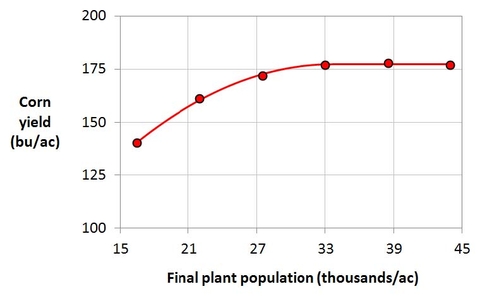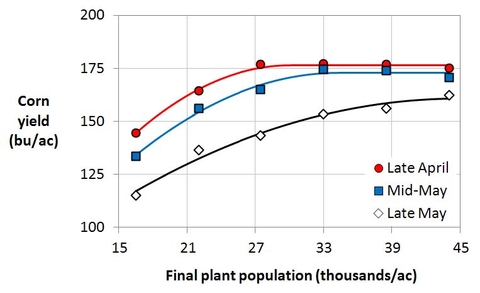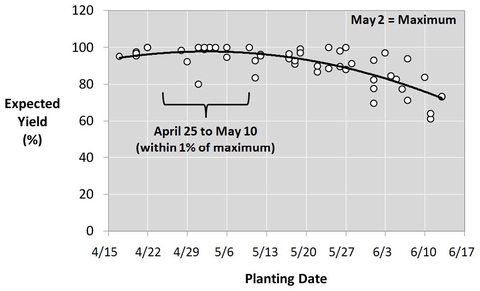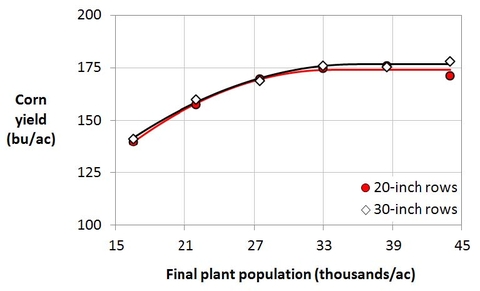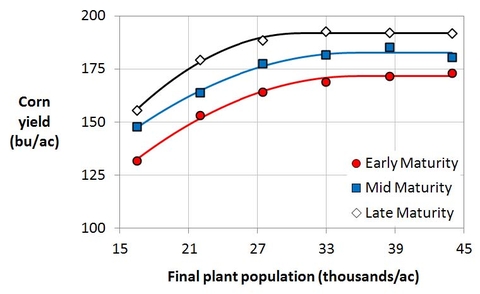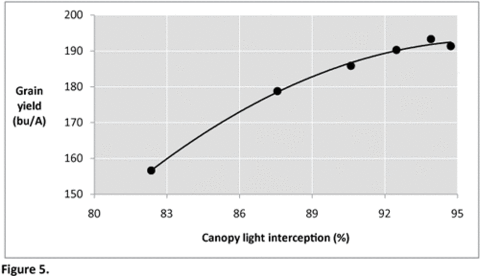Quick facts
- To maximize profitability, the final plant population should range from about 32,000 to 34,000 plants per acre.
- The optimum plant population does not change if corn is planted by mid-May.
- The optimum plant population is not affected by row width.
- Optimum plant populations are not affected by relative maturity for mid- and late-hybrids.
With increasing corn production costs and fluctuating grain prices, it’s critical that corn growers make sound decisions about planting to maximize profits. Decisions related to planting rate are especially important, since seed represents about 15 percent of the total cost of corn production according to an Iowa State University report.
From 2005 to 2011, researchers evaluated how corn yields in southern and central Minnesota responded to plant population, and whether planting date, hybrid maturity and row width affected this.
Maximizing profit
To maximize profit, research shows Minnesota growers need a final stand of 32,000 to 34,000 plants per acre (Figure 1), although this varies with the cost of seed and corn price. Corn yields were maximized near a final stand of 33,000 plants per acre and were not reduced as plant population increased to 44,000 plants per acre.
Planting rates
Planting rates should be higher than the optimum plant population to compensate for early season stand losses. Based on Figure 1, planting rates of 34,000 to 36,000 seeds per acre maximize net return in most fields.
Like the final stand needed to maximize profit, economically optimum seeding rates vary with corn price and seed costs. We calculated seeding rates (seeds per acre) to get within $1 of the maximum net return in Table 1. These seeding rates are 5 percent above the targeted population to compensate for early season losses.
Table 1: Seeding rates (seeds per acre) to maximize net return
| Seed cost | $4/bushel corn price | $6/bushel corn price | $8/bushel corn price |
|---|---|---|---|
| $225/bag | 30,700 to 33,700 | 32,100 to 34,400 | 32,700 to 34,700 |
| $275/bag | 30,100 to 32,900 | 31,700 to 34,000 | 32,400 to 34,400 |
| $325/bag | 29,400 to 32,300 | 31,200 to 33,500 | 32,100 to 34,100 |
Factors affecting optimum plant population
Research conducted in Lamberton and Waseca found that the optimum plant populations were not affected if corn was planted by mid-May (Figure 2). However, when planting was delayed until late May, a higher plant population was needed to maximize yield.
Timely planting in good soil conditions is the foundation for successful corn production. Studies show that little yield reduction occurs if corn is planted by mid-May. However, yield drops off quickly when planting was delayed beyond mid-May (Figure 3).
Researchers evaluated how corn yield responds to 20- and 30-inch row spacings over a range of plant populations. They found that narrow rows did not significantly increase yield at any plant population level and that the economically optimum plant population of both row widths was similar (Figure 4).
Guide to narrow-row corn planting in Minnesota
Row width and relative maturity
Researchers also evaluated how hybrids in different maturity groups responded to the 20- and 30-inch row spacings at different population levels. The early-, mid-, and late-maturity hybrids studied in southern Minnesota were 95-, 101- and 105-day relative maturities (RM). In west central Minnesota, the hybrid RMs were 91-, 94- and 99-day.
Optimum planting rates and corn grain yields were generally not affected by row width for mid- to late-maturity corn hybrids.
However, early-maturity hybrids (less than 90-day relative maturity) planted in northwestern Minnesota produced 4 to 5 percent higher grain yield when planted in rows narrower than 30 inches. These early-maturity hybrids also had optimum planting rates that were 3,500 seeds per acre greater when planted in narrow rows.
These studies found higher corn yields with mid- and late-maturity hybrids than early-maturity hybrids (Figure 5). The study evaluated 95-, 101-, and 105-day RM hybrids in southern Minnesota, and 91-, 94- and 99-day RM in west central Minnesota.
Optimum planting rates differed only slightly for the different maturity group hybrids. For early maturity hybrids, the optimum planting rates tended to be near or above the high end of the recommended 34,000 to 36,000 seeds per acre range (96-day RM or earlier). This is particularly true for hybrids less than 90-day RM.
Since earlier-maturing hybrids tend to be shorter and have less leaf area than full-season hybrids, it’s possible they require higher plant populations to optimize light interception.
While optimum planting rate differs somewhat among hybrids, hybrid selection generally impacts yield more than fine-tuning planting rates by hybrid.
Research shows the economic optimum plant population is greater under higher-yielding environments.
An Illinois study reported that as yield potential increased from 135 to 225 bushels per acre, the economically optimum plant population increased from about 25,000 to 32,000 plants per acre. For every yield increase of 10 bushels per acre, the optimum plant population increased by about 800 plants per acre.
While a too-high plant population generally will not reduce yield, it will reduce net return. In recent trials in northwestern Minnesota where growing season rainfall was just 10 to 15 inches, grain yield ranged from 100 to 130 bushels per acre and was not reduced with final stands up to 44,000 plants per acre.
Estimating yield loss
To determine how a lower plant population will affect yield loss, refer to Table 2. This visual shows averages across experiments, and is a useful tool for estimating yield loss caused by unexpected weather or soil conditions.
Table 2: How the final plant stand impacts yield
| Final stand (plants per acre) | Expected yield |
|---|---|
| 44,000 | 100% |
| 41,000 | 100% |
| 38,000 | 100% |
| 35,000 | 100% |
| 32,000 | 100% |
| 29,000 | 99% |
| 26,000 | 96% |
| 23,000 | 92% |
| 20,000 | 87% |
| 17,000 | 81% |
Grain yield increases from higher plant populations are primarily caused by crop canopies intercepting more light during grain-fill.
In a 2008 planting date trial in Lamberton and Waseca, researchers measured light interception by the crop canopy just after silking (Figure 6). Each data point in Figure 6 represents canopy light interception and the corresponding grain yield for each level of plant population, averaged across three planting dates and two locations.
Results show that as plant population increased from 15,600 to 32,400 plants per acre, canopy light interception increased from 82 to 92 percent and grain yield increased from 157 to 190 bushels per acre. However, as plant population increased from 32,400 to 43,600 plants per acre, light interception only increased from 92 to 95 percent and grain yield increased by just 1 bushel per acre.
Figure 6 also suggests a relationship between optimum plant population and the amount of light interception during grain-fill. The economically optimum plant population is likely near the minimum plant population needed to intercept the majority of light during grain-fill.
Optimizing light interception
Research suggests growers manage plant population with the goal of optimizing light interception. Fields with optimum plant population have very little sunlight hitting the soil surface, and very few plants without ears.
To evaluate light interception during grain-fill, look under the crop canopy near solar noon on a calm, sunny day.
Coulter, J. & Shanahan, J. (2012). Corn response to row width, plant population, and hybrid maturity in the far northern Corn Belt.
Nafziger, E.D. (1994). Corn planting date and plant population.
Van Roekel, R.J. & Coulter, J.A. (2011). Agronomic responses of corn to planting date and plant density. Agronomy Journal, 103(5), 1414-1422. Agronomic Responses of Corn to Planting Date and Plant Density.
Van Roekel, R.J. & Coulter, J.A. (2012). Agronomic responses of corn hybrids to row width and plant density. Agronomy Journal, 104(3), 612-620. Agronomic Responses of Corn Hybrids to Row Width and Plant Density.
Plastina, A. (2018). Estimated costs of crop production in Iowa - 2018.
Reviewed in 2021


